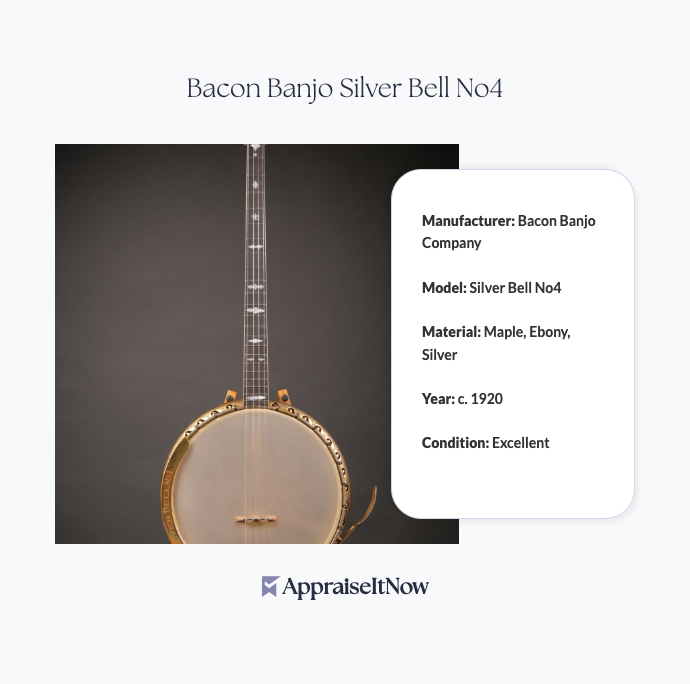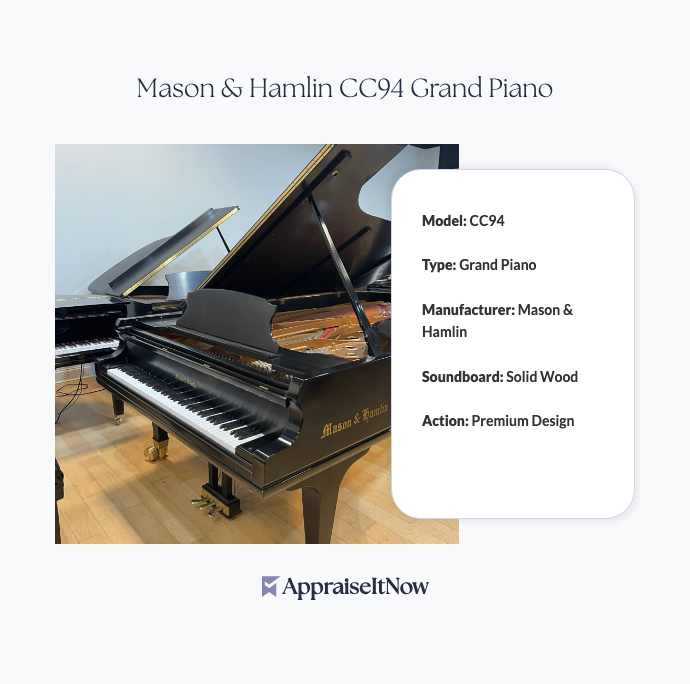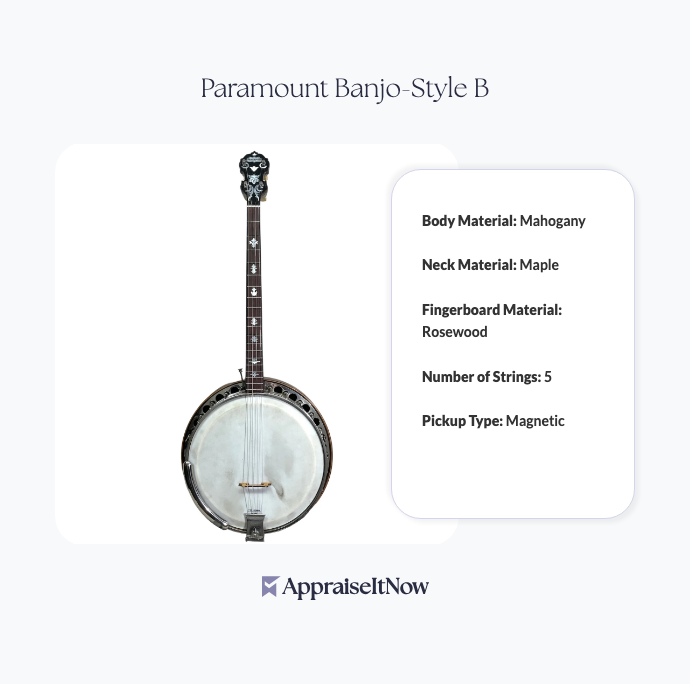<h1>How to Get Your Bacon Banjo Silver Bell No4 Appraised</h1>
<p>The Bacon Banjo Silver Bell No4 represents a significant piece of American musical heritage, with market valuations ranging from <strong>$3,500 to $5,000</strong> for quality examples. Whether you've inherited a family heirloom, discovered one at an estate sale, or are considering a purchase, understanding how to properly appraise this iconic instrument ensures you have accurate documentation for insurance, sale, or collection purposes.</p>
<h2>Understanding Your Bacon Banjo Silver Bell No4</h2>
<p>The Bacon Banjo Silver Bell No4 stands as a pinnacle of early-20th-century banjo craftsmanship, first introduced in <strong>1920</strong> by the renowned Bacon & Day company. Your instrument isn't simply a musical tool—it's a collectible asset that combines exceptional playability with distinctive artistic design, making it highly sought after by both professional musicians and serious collectors alike.</p>
<p>What sets the Silver Bell No4 apart from other banjos of its era? The defining feature is its <strong>solid silver bell-shaped tone ring</strong>, a technical innovation that produces a uniquely rich and resonant sound. This distinctive tonal quality, combined with the instrument's carved maple neck and ebony fingerboard, creates an object of both functional musicality and aesthetic value. The intricate engraved design further elevates its status as a work of art rather than merely a utility instrument.</p>
<div class="callout tip"><p><strong>Collector's Insight</strong></p>
<p>Original Bacon banjos from the 1920s era command significantly higher values than later reproductions due to their hand-crafted components and superior materials.</p></div>
<h2>Key Value Drivers for Your Silver Bell No4</h2>
<p>When professional appraisers evaluate a Bacon Banjo Silver Bell No4, several critical factors determine its position within that <strong>$3,500-$5,000</strong> valuation range. The instrument's exceptional craftsmanship—evidenced by its solid silver tone ring, carved maple construction, and ebony fingerboard—immediately distinguishes it from mass-produced instruments. However, your specific piece's condition, originality, and provenance create individual value variations worth understanding.</p>
<h3>Condition and Originality Factors</h3>
<p>The physical state of your banjo directly affects appraisal outcomes. Appraisers examine the integrity of the silver tone ring for tarnish or damage, assess the maple neck for warping or cracks, and evaluate the ebony fingerboard for wear patterns. Original hardware, tuning pegs, and the vellum head all contribute to authenticity verification. Even the engraving's depth and clarity influence perceived value, as deteriorated artwork suggests either age wear or past restoration work that may have diminished originality.</p>
<p>Documentation of originality matters significantly. A Bacon Silver Bell No4 with all matching serial numbers, original case, and minimal playing wear will appraise considerably higher than an otherwise identical instrument with replaced components or extensive restoration. When seeking professional valuation through resources focused on <a href="/types/memorabilia-and-collectibles">musical memorabilia and collectibles</a>, bring any documentation of previous ownership, maintenance records, or certificates of authenticity.</p>
<h3>Market Demand and Collector Interest</h3>
<p>The broader market for vintage banjos continues strengthening, particularly for instruments with documented manufacturer heritage. The Bacon company's reputation for innovation and quality attracts both amateur historians and professional musicians who value performance alongside investment potential. Unlike some niche collectibles with limited appeal, the Bacon Silver Bell No4 benefits from sustained interest across multiple collector demographics—from bluegrass traditionalists seeking authentic period instruments to jazz musicians interested in vintage tone characteristics.</p>
<div class="callout note"><p><strong>Market Context</strong></p>
<p>Bacon banjos consistently outperform many other vintage instrument categories in appreciation and collector demand, making professional appraisal particularly valuable for portfolio tracking.</p></div>
<h2>Documentation That Increases Appraisal Value</h2>
<p>Professional appraisers approach your Bacon banjo similarly to how they evaluate <a href="/types/antique-silver">antique silver</a> or other heritage items—through comprehensive documentation of authenticity and provenance. Gathering specific paperwork substantially impacts the appraisal outcome and your instrument's resale potential.</p>
<p>Essential documentation includes the original serial number and any factory marks, photographs documenting condition from multiple angles, maintenance or repair records showing professional care, previous ownership history if available, and any correspondence from prior owners regarding the instrument's background. If your Silver Bell No4 accompanied original accessories like the case, stand, or strap, these increase value and should be documented.</p>
<p>Provenance particularly matters for vintage instruments. If you can trace ownership history—such as documentation of a previous owner's professional performances or the instrument's role in specific musical traditions—this narrative substantially enhances appraisal value. Some collectors seek banjos with verified concert history or association with notable musicians, commanding premium valuations compared to instruments with unknown backgrounds.</p>
<h2>Authentication Markers and Maker Verification</h2>
<p>Understanding how appraisers verify your instrument's authenticity helps you prepare thorough documentation. The Bacon company employed specific manufacturing techniques and serial numbering systems that evolved over production years. The solid silver bell-shaped tone ring, while distinctive, requires expert evaluation to confirm authentic silver content versus plating. Serial number placement, font styles, and hardware specifications all serve as authentication checkpoints.</p>
<p>Qualified appraisers with experience in vintage musical instruments examine construction methods that distinguish genuine Bacon factory work from later reproductions. The quality of the maple carving, the precision of the ebony fingerboard inlay, and the consistency of the engraved design patterns all provide authentication evidence. This expertise parallels the specialized knowledge required for <a href="/types/antique-artwork">antique artwork</a> or <a href="/types/antique-jewelry">antique jewelry</a> appraisals, where genuine items command dramatically higher values than reproductions.</p>
<p>Professional appraisers often reference detailed catalogs documenting Bacon & Day production variations across different years and model series. By cross-referencing your instrument against these historical records, they confirm period-appropriate specifications and identify any modifications or repairs that might affect authenticity claims.</p>
<h2>Condition-Based Valuation Ranges</h2>
<p>While the <strong>$3,500-$5,000</strong> estimate provides a useful baseline, individual appraisals vary significantly based on condition assessment. An exceptional example—one with pristine silver finish, uncracked maple neck, original hardware, flawless ebony fingerboard, and sharp engraving detail—would appraise toward the upper range. Conversely, an instrument showing years of performance wear, previous repairs, refinished hardware, or tarnished silver might appraise in the lower bracket.</p>
<p>Consider these condition markers when evaluating your banjo's likely value position:</p>
<p>The sound quality, while important to musicians, indirectly influences appraisal value through the condition assessment. An instrument that plays beautifully suggests proper maintenance and care, enhancing perceived condition grading. Conversely, a banjo requiring significant restoration work or showing structural damage would lower appraisal estimates substantially.</p>
<div class="callout tip"><p><strong>Preparation Tip</strong></p>
<p>Before scheduling an appraisal, gently clean your Bacon banjo with appropriate materials and document its current condition with clear photographs from multiple angles and under good lighting.</p></div>
<h2>Professional Appraisal Methodology</h2>
<p>When you engage a professional appraiser for your Silver Bell No4, expect a systematic evaluation process. The appraiser conducts a hands-on inspection examining the tone ring composition, neck straightness, fretboard wear patterns, hardware condition, and original finishes. Photographic documentation from multiple angles becomes part of the formal appraisal record, creating visual evidence of condition assessment.</p>
<p>Qualified appraisers then research comparable sales of similar Bacon banjos, consulting recent auction results, private sales when available, and dealer listings to establish market-supported valuations. They apply their expertise in understanding how rarity, condition, provenance, and collector demand intersect to determine fair market value. This comprehensive approach ensures your appraisal reflects genuine market conditions rather than speculation.</p>
<p>The resulting USPAP-compliant appraisal report provides detailed descriptions, condition grading, comparative analysis, and justified conclusions supporting the final valuation. These certified reports serve multiple purposes—establishing insurance replacement costs, supporting estate valuations, documenting asset values for investment portfolios, or substantiating prices in sales negotiations. Whether you're exploring <a href="/types/personal-property">personal property</a> appraisal requirements or preparing for estate planning, professional appraisal documentation proves invaluable.</p>
<h2>Restoration Considerations and Value Impact</h2>
<p>A common concern among Bacon banjo owners involves whether professional cleaning or restoration might enhance appraisal value. Here's the reality: while some restoration work improves playability and aesthetic appeal, it typically reduces collector value compared to original condition preservation. The patina on a silver tone ring, even if tarnished, carries authenticity significance that polishing removes.</p>
<p>Appraisers specifically note any restoration work in their evaluations, and professional restoration—while preferable to amateur attempts—generally reduces values relative to unrestored examples. The exception occurs when restoration addresses structural damage threatening the instrument's integrity, where professional repair might actually preserve or restore value that unchecked deterioration would further diminish.</p>
<p>If you're considering restoration, obtain a pre-restoration appraisal first, then consult with the appraiser about which work genuinely impacts value. This approach helps you make informed decisions balancing improved playability against potential collector premium reductions.</p>
<h2>Where and How to Sell Your Valued Banjo</h2>
<p>Understanding potential sales channels informs your appraisal strategy. High-value Bacon banjos like the Silver Bell No4 sell through multiple venues—specialized vintage instrument dealers, online auction platforms focused on musical collectibles, regional antique markets, or direct sales to collectors through social media and collector networks.</p>
<p>Different sales channels yield different results. Auction houses with specialized musical instrument categories provide market transparency and reach serious collectors, though buyer premiums and auction house fees reduce net proceeds. Specialized dealers offer convenience and faster sales with lower commissions but may offer less than private collector sales. Direct sales to identified collectors through community networks sometimes achieve premium prices when the buyer's specific needs match your instrument's characteristics.</p>
<p>Your appraisal documentation supports negotiations across all these channels by establishing credible valuation grounded in professional expertise and market analysis. Serious buyers expect proper documentation, and certified appraisals from qualified experts significantly strengthen your negotiating position.</p>
<h2>Insurance and Estate Planning Applications</h2>
<p>Professional appraisal of your Bacon Silver Bell No4 serves critical insurance functions. Standard homeowners policies often inadequately cover valuable musical instruments, requiring specific riders or separate coverage to ensure replacement value protection. Insurers require certified appraisals documenting the instrument's value, condition, and special characteristics that distinguish it from mass-produced alternatives.</p>
<p>For estate planning purposes, accurate appraisals of significant assets like valuable instruments ensure proper asset distribution among heirs and minimize tax complications. When musical instruments represent meaningful portions of total estate value, professional appraisals provide necessary documentation supporting valuations used in estate settlement negotiations and tax filings.</p>
<hr />
<div class="callout note"><p><strong>Key Takeaway</strong></p>
<p>A certified appraisal of your Bacon Banjo Silver Bell No4 provides essential documentation for insurance coverage, estate planning, sales negotiations, or investment tracking. Professional appraisers bring specialized expertise in authenticating vintage instruments, researching comparable market values, and delivering USPAP-compliant valuations that protect your financial interests whether you're buying, selling, insuring, or preserving this exceptional piece of American musical heritage for future generations.</p></div>







.avif)







